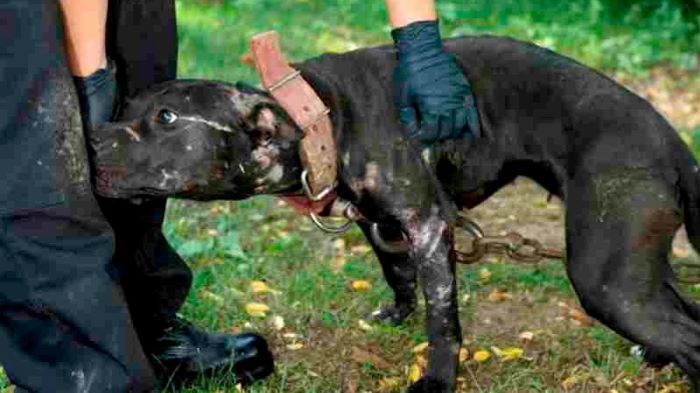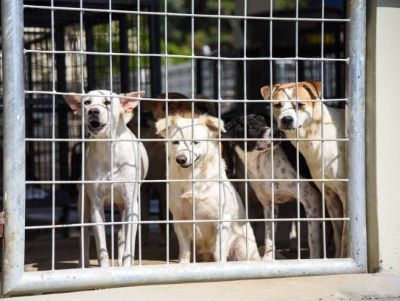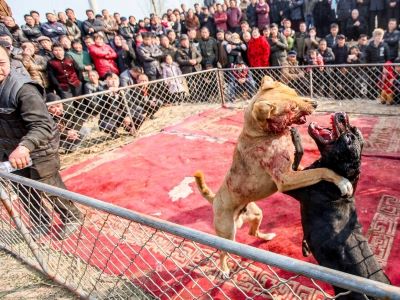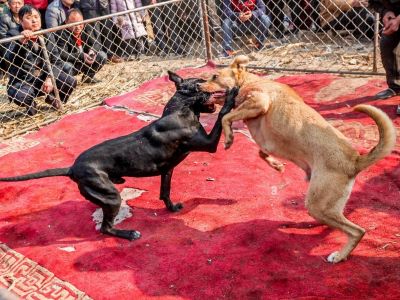Dog fighting is a cruel and illegal activity that involves pitting two or more dogs against each other in a ring or a pit for the entertainment or profit of spectators. But before these dogs enter the arena, they are often trained and conditioned using live animals as bait.
These animals are known as bait dogs, and they are subjected to unimaginable pain and suffering at the hands of their abusers.

According to the Humane Society of the United States, there are an estimated 40,000 people involved in professional dog fighting and hundreds of thousands more in street-level dog fighting in the U.S. alone.
The exact number of bait dogs used and killed in this brutal industry is unknown, but it is likely to be in the tens of thousands every year.
The purpose of this article is to shed some light on the plight of bait dogs, and to explore the signs and symptoms, the legal and ethical issues, and the rescue and rehabilitation of these innocent victims of dog fighting.
Contents
What Are Bait Dogs? Signs and Symptoms of Bait Dogs
Bait dogs are abused and killed by dog fighters to train their fighting dogs. They are often gentle dogs that cannot fight back.
“Bait” animals are animals used to test a dog’s fighting instinct; they are often mauled or killed in the process. Many of the training methods involve torturing and killing of other animals.
They are obtained from various sources, sometimes stolen from their owners. They may also be failed fighting dogs that are used as bait instead.

Signs and Symptoms of Bait Dogs
Bait dogs are dogs that are used as live training targets for fighting dogs. They are exposed to various types of baits, such as rat poison or snail pellets, that can cause serious harm or death.
They may also suffer from injuries, scars, infections, and diseases as a result of being attacked by other dogs.[1]
Bait dogs often show physical and behavioral signs of abuse and trauma, such as:
- Weakness and lethargy
- Breathing difficulty
- Pale bleeding gums or a bloody nose
- Bruising or lumps
- Wobbly gait
- Tremors or convulsions
- Excessive panting
- Excessive drooling
- Fearfulness or aggression
- Anxiety or depression
How to Identify a Bait Dog
It can be hard to tell if a dog is a bait dog or a stray or abused dog, as they may share similar signs and symptoms. However, there are some clues that can help you identify a bait dog, such as:
a). The Location and Pattern of The Injuries: Bait dogs may have wounds on their face, neck, chest, legs, and genitals, as these are the areas that fighting dogs target.[2]
They may also have multiple bite marks or punctures that indicate repeated attacks.
b). The Presence of Foreign Substances in The Dog’s Body: Bait dogs may have ingested or been injected with poisons, drugs, or sharp objects that are used as baits.
These can cause internal bleeding, organ damage, or infections. You may notice unusual material in the dog’s stool, such as green or corn-like substances that might be rodenticide ingestion.

c). The History and Behavior of The Dog: Bait dogs may have been stolen from their owners, bought from pet stores or online ads, or taken from shelters.
They may have been kept in cages, chains, or dark places with little food or water. They may show signs of fear, distrust, or aggression towards humans or other animals.
They may also have difficulty in socializing, playing, or bonding with others.
- If you suspect that a dog is a bait dog, you should contact your local animal shelter, rescue group, veterinarian, or police.
- They can help you confirm the situation and provide the necessary care and support for the dog.
- You should also report any suspicious activity or evidence of dog fighting or baiting to the authorities.
Some examples of bait dogs that were rescued or identified are:
Example#1
A pit bull named Oogy, lost part of his face and an ear as a result of being used as a bait dog when he was a puppy.
Police discovered him during a search and took him to a veterinary clinic where he was adopted by a caring family.

Example#2
After being exploited as a bait dog, a Labrador retriever named Honey was discovered to have terrible wounds and illnesses.
She endured a number of operations and therapies after being saved by an animal protection group. She healed gradually and discovered her forever home.
Example#3
A terrier mix named Daisy was flung over a fence into a yard where two dogs were fighting. She had a terrible mauling and was left for dead. She was found by a neighbor, who then requested assistance.
She had emergency surgery at the veterinary facility where she was transported. She made it through and was adopted by a kind couple.
The Legal and Ethical Issues of Bait Dogs
Bait dogs experience not just animal cruelty but also illegal behavior that violates the law and accepted social values. Dog fighting and dog baiting are prohibited in all 50 US states as well as many other countries and regions.
Yet, the laws and penalties vary widely and usually fail to take into consideration the seriousness of the offense or the harm caused to the animals.

Laws and Penalties for Dog Fighting and Baiting
According to the Animal Legal Defense Fund, dog fighting is a felony offense in all 50 states, but only 28 states have felony penalties for possessing a fighting dog.[3]
The maximum prison sentence for dog fighting ranges from one year to 20 years, depending on the state. The maximum fine ranges from $2,500 to $250,000.
Baiting is also a felony offense in most states, but some states do not have specific laws against it or only consider it a misdemeanor.
The maximum prison sentence for baiting ranges from six months to 10 years, depending on the state. The maximum fine ranges from $500 to $100,000.
In addition to criminal penalties, some states also allow for civil remedies, such as seizure and forfeiture of any dogs or other animals used for fighting or baiting, restitution for veterinary costs and care of the animals, and injunctions or restraining orders against further involvement in dog fighting or baiting.
However, despite the existence of these laws and penalties, dog fighting and baiting are still prevalent and difficult to detect and prosecute.

Some of the challenges and limitations include:
- The underground and secretive nature of dog fighting and baiting, which makes it hard to gather evidence and identify suspects.
- The lack of resources and training for law enforcement and animal control agencies to investigate and respond to dog fighting and baiting cases.
- The low priority given to dog fighting and baiting cases by some prosecutors and judges, who may view them as minor crimes or victimless offenses.
- The intimidation and fear of retaliation by dog fighters and baiters, who may threaten or harm witnesses, informants, or animal rescuers.
- The lack of public awareness and education about the signs and symptoms of dog fighting and baiting, and how to report them.
The Rescue and Rehabilitation of Bait Dogs
Bait dogs are not only victims of animal cruelty, but also survivors of incredible resilience and courage. Many of them can be rescued and rehabilitated, and end up in loving homes where they can enjoy a new life of safety and happiness.[4]
However, this process is not easy or simple, and requires the involvement and commitment of various people and organizations.
The Process of Rescuing and Rehabilitating Bait Dogs
Rescuing and rehabilitating bait dogs involves several steps and challenges, such as:
- Finding and seizing the bait dogs from their abusers,
- Providing medical care and treatment for the bait dogs,
- Evaluating the behavior and temperament of the bait dogs,
- Rehabilitating the bait dogs physically and emotionally,
- Finding suitable homes or placements for the bait dogs.

Some resources or tips for helping or supporting bait dogs and their caregivers are:
- Learn more about dog fighting and baiting , their signs , symptoms , effects , laws , penalties , prevention , intervention , etc.
- Report any suspected cases of dog fighting or baiting to your local animal shelter , rescue group , veterinarian , police , or hotline.
- Support your local animal shelter , rescue group , veterinarian , or other organization that rescues and rehabilitates bait dogs by volunteering , donating , fostering , adopting , spreading the word , etc.
- Educate yourself , your family , your friends , your community , your students , your colleagues , etc. about dog fighting and baiting , their harms , their alternatives , their solutions , etc.
- Respect all animals as living beings that deserve care and compassion , and treat them accordingly.
FAQs
What does it mean for a dog to be a bait dog?
A bait dog is a dog that is abused and killed by dog fighters to train their fighting dogs. Bait dogs are exposed to various types of baits. They may also suffer from injuries, scars, infections, and diseases as a result of being attacked by other dogs.
How do I know if my dog was a bait dog?
It can be hard to tell if a dog was a bait dog or a stray or abused dog, as they may share similar signs and symptoms. However, there are some clues such as bait dog may have injuries, foreign substances, and behavioral problems that indicate abuse by dog fighters.
What dogs are used as bait?
Bait dogs come from a wide variety of sources and represent a large selection of different breeds or mixed breeds. Some dog fighters prefer to try to find dogs that are more gentle and submissive by nature. However, many believe that these trainers will use any dog that is available to them for no cost.
Are bait dogs aggressive?
Bait dogs are not naturally aggressive, but they may become fearful or defensive due to the abuse and trauma they have experienced. Bait dogs may show signs of fear, distrust, or aggression towards humans or other animals, especially if they perceive them as a threat or a source of pain.
Conclusion
In this article, we discussed what are bait dogs, the signs and symptoms of bait dogs, and how to identify them. Also the legal and ethical issues of bait dogs, Rescue, and rehabilitation of bait dogs.
- Bait dogs are dogs that are abused and killed by dog fighters to train their fighting dogs.
- Dog fighting and baiting are illegal and immoral activities that harm animals and society.
- Bait dogs are survivors that can be rescued and rehabilitated with the help of various people and organizations.
- We can all play a role in helping or supporting bait dogs and their caregivers by taking various actions.
We can make a difference in the lives of bait dogs and other animals, and create a better world for ourselves and our animal friends.
“Bait dogs deserve care and compassion, not abuse and neglect.”
References:
- Cannon, S. H., J, L., Kirk, S., Crawford, P., Leutenegger, C. M., Shuster, J. J., Liu, J. B., & R, C. (2016). Infectious diseases in dogs rescued during dogfighting investigations. Veterinary Journal, 211, 64–69. – ScienceDirect
- Bel-Rea. (n.d.). Dogfighting Awareness – Institute of Animal Technology. Retrieved June 21, 2023, from – BelRea
- Mota-Rojas, D., Mariti, C., Marcet-Rius, M., Lezama-García, K., Gazzano, A., Hernández-Ávalos, I., Mora-Medina, P., Domínguez-Oliva, A., & Whittaker, A. L. (2022). The Welfare of Fighting Dogs: Wounds, Neurobiology of Pain, Legal Aspects and the Potential Role of the Veterinary Profession. Animals, 12(17), 2257. – MDPI
- Crowley, A. (2023, June 9). What Is A Bait Dog? Things You Don’t Know. Vet Ranch. Retrieved June 21, 2023, from – VETRANCH

John is an ardent animal activist, avid pet lover, and founder of DogLikesBest. He provides all pet-related mentoring to pet rescue centers, animal shelters, and veterinary hospitals. John also has immense knowledge in day-to-day pet care. John also writes some of the featured articles on DogLikesBest. He likes sharing his experience that he has had in the past career. He also likes to share his recommendation of products, especially the ones that have been tried & tested out by him.


